Introduction
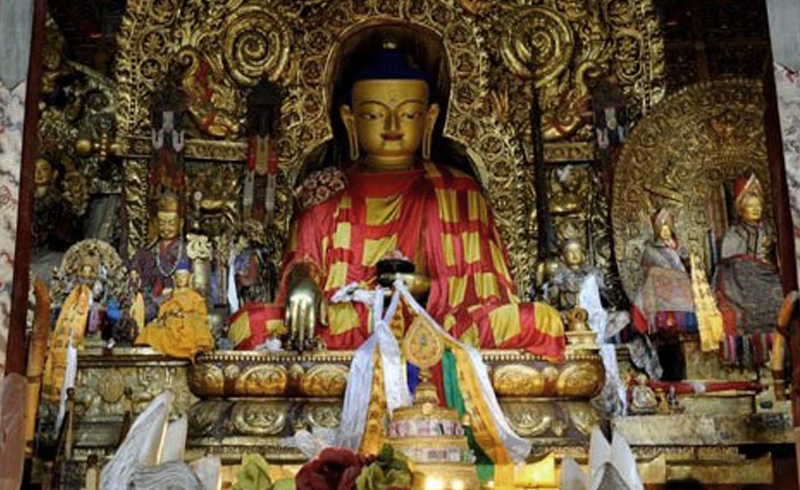
Statue of Buddha Shakyamuni at Sakya Monastery, Tibet
Buddha Shakyamuni, commonly known as Prince Siddhartha, manifested spiritual enlightenment over twenty-five centuries ago in ancient India, following his diligent efforts to solve the suffering of living beings. Out of compassion and to suit the abilities of different students, the Buddha gave extensive and varied teachings. Among the Buddha’s teachings are the sutras and tantras. The sutras primarily contain the explanation of 1) the four noble truths on suffering, its cause, the cessation of suffering, and the path to cessation; 2) the perfection of wisdom on the true nature of self and phenomena; and 3) finally, the definitive principle that every sentient being has the same inherent nature as the Buddha. Based on this definitive principle, the tantras describe spiritual practices that can lead to enlightenment in one lifetime. The Buddha’s advanced teachings, and especially the tantras, were not conferred in an ordinary way to the public. Rather, they were conferred to students of superior qualities and, at appropriate times, introduced to human beings, such as the eighty-four mahasiddhas of India and Nepal.
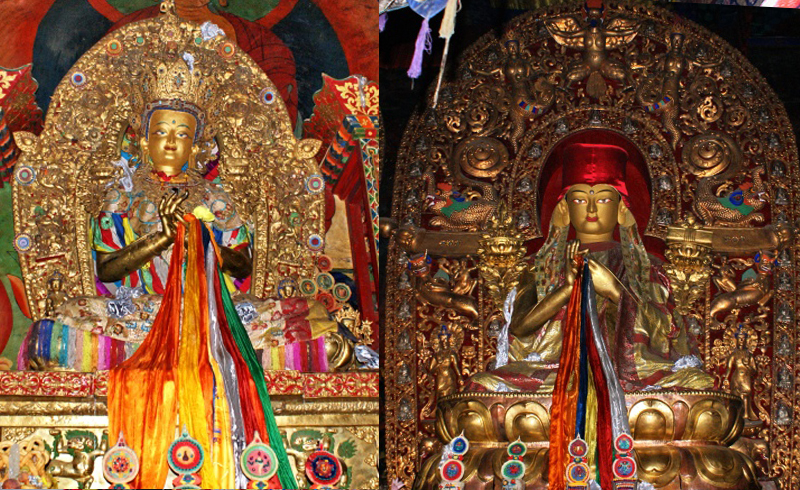
Statues of Bodhisattva Manjushri and Choje Sakya Pandita at Sakya Monastery, Tibet
The Sakya lineage is one of the main Tibetan Buddhist traditions and upholds the teachings of both sutra and tantra. It is led by an unbroken hereditary line of spiritual masters. This family is known by three names: Lha Rig, Khon, and Sakya. The family was first known as Lha Rig, meaning celestial race, because its ancestors descended from the clear light heavens to the high mountains of Tibet. The family later became known as Khon, meaning dispute or strife, after a family member defeated a harmful being in a dispute and then had a son with his opponent’s former wife. The inner meaning of Khon is defeating ignorance. The Khon family thus has this special quality of spiritual wisdom.
Centuries later, in 1073 C.E., Khon Konchog Gyalpo founded Sakya Monastery in central Tibet. Sakya, meaning pale earth, was given its name due to the color of the ground by the monastery. Guru Padmasambhava and Atisha foretold this location as a holy center where the Buddha Dharma would flourish. In accordance with Atisha’s prophecy, the Sakya family lamas are regarded as emanations of Avalokiteshvara (the embodiment of Buddha’s compassion), Vajrapani (the embodiment of Buddha’s power), or especially Manjushri (the embodiment of Buddha’s wisdom).
Historical Development

Sachen Kunga Nyingpo
In the eighth century, the Khon family became students of Guru Padmasambhava, the master who facilitated Buddhism’s establishment in Tibet. Guru Padmasambhava primarily oversaw the translation of tantras from Sanskrit to Tibetan, and the abbot Shantarakshita primarily oversaw the translation of sutras. At this time, a Khon family member was ordained as one of the first seven monks in all of Tibet. For the next several generations, the Khon family upheld practices of the old translation school.
In the eleventh century, Khon Konchog Gyalpo sought to revitalize the Buddha Dharma after witnessing public laxity in spiritual practice. He therefore requested newly translated tantras from Drogmi Lotsawa, who had studied Sanskrit and received authentic teachings from masters of India and Nepal. Having received these new teachings and founded Sakya Monastery, Khon Konchog Gyalpo established the Sakya order as its own Buddhist tradition.
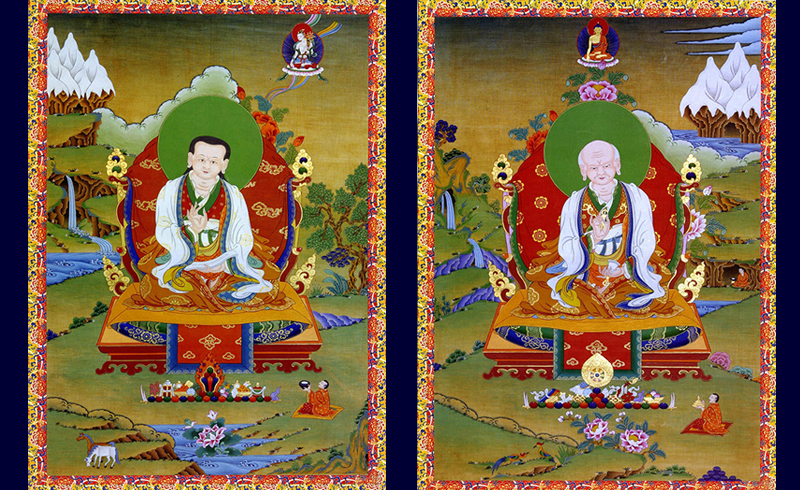
Lopon Sonam Tsemo (l) and Jetsun Dragpa Gyaltsen (r)
Khon Konchog Gyalpo’s son Sachen Kunga Nyingpo studied with the greatest masters of his day and received many sutra and tantra teachings. The Sakya lineage was then held under the successive leadership of Lopon Sonam Tsemo, Jetsun Dragpa Gyaltsen, Choje Sakya Pandita, and Drogon Chogyal Phagpa. Together with Sachen Kunga Nyingpo, these subsequent masters are known as the five founding fathers of the Sakya lineage. Each was renowned for his exceptional qualities, authored many treatises, and achieved success in both spiritual and temporal affairs. Sakya Pandita and Chogyal Phagpa tutored the Mongol Khans and were granted political rule over Tibet. From the thirteenth to fourteenth century, the Sakya clan oversaw Tibet’s temporal affairs and worked to ensure a peaceful era.
Similar to other Buddhist schools, sub-traditions of the Sakya emerged in Tibet. In the fifteenth and sixteenth centuries, the sub-traditions established outside of Sakya Monastery were the Ngor by the abbot Ngorchen Kunga Zangpo, the Tsar by Tsarchen Losal Gyatso, and the Dzongpa by Dorjedenpa Thumi Kunga Namgyal.
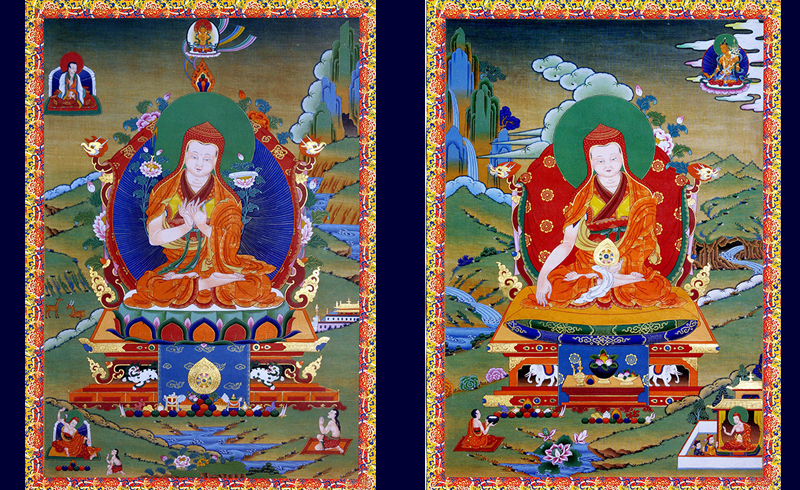
Choje Sakya Pandita (l) and Drogon Chogyal Phagpa (r)
Over the centuries, many other Sakya practitioners illuminated Tibet. Buton Rinchen Drub, for example, was one of Tibet’s notable scholars and historians. Also, the masters known as the six ornaments of Tibet were renowned Sakya practitioners: Yagton Sangye Pal and Rongton Sheja Kunrig were reputed for their mastery of the sutras. Ngorchen Kunga Zangpo and Dzongpa Kunga Namgyal were highly learned in the tantras and, as already mentioned, established sub-traditions of Sakya. Gorampa Sonam Senge and Shakya Chogden were highly learned in both the sutras and tantras and known for their philosophical expositions.
In the nineteenth century, the celebrated master of Dzongsar monastery, Jamyang Khyentse Wangpo, co-founded Tibet’s nonsectarian movement. He collected, systemized, and authored numerous teachings that are practiced in Sakya monasteries and other Buddhist schools.
Sakya Today
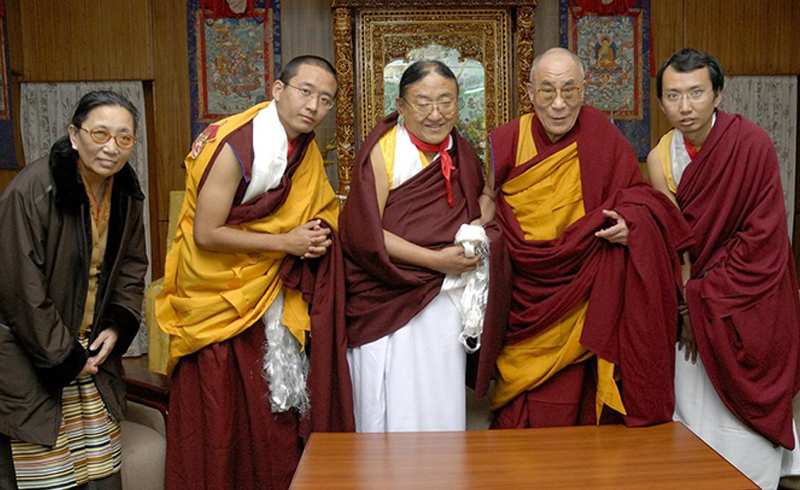
His Holiness the Dalai Lama with His Holiness Kyabgon Gongma Trichen and Dolma Phodrang family members
In recent times, the Sakya lineage has been held by two branches of the Khon family, the Dolma Phodrang and the Phuntsok Phodrang. Members of each branch have alternated serving as the lineage head.
His Holiness Kyabgon Gongma Trichen Rinpoche of the Dolma Phodrang was born in Tibet in 1945. His Holiness was subsequently designated as the 41st Sakya Trizin or throne holder of the lineage. Like many Tibetan lamas of his generation, His Holiness fled Tibet in 1959 following the political and cultural upheaval in his homeland. His Holiness established Sakya Centre as his seat in India and decades later established Tsechen Kunchab Ling in Walden, New York, as his seat in the United States. Under His Holiness’ guidance, Sakya institutions for Dharma study and practice now thrive around the world.
His Holiness has two sons, Khondung Ratna Vajra Rinpoche and Gyana Vajra Rinpoche. Both have practiced the Buddha Dharma under His Holiness’s guidance since birth. On March 9, 2017, Ratna Vajra Rinpoche accepted the mantle of leadership from his esteemed father and root guru, in his new capacity as the 42nd Sakya Trizin. Jetsun Kushok Chimey Luding, the sister of His Holiness Kyabgon Gongma Trichen, is also a fully qualified lineage holder, having received religious training alongside her brother in Tibet. Jetsun Kushok currently resides in Canada.
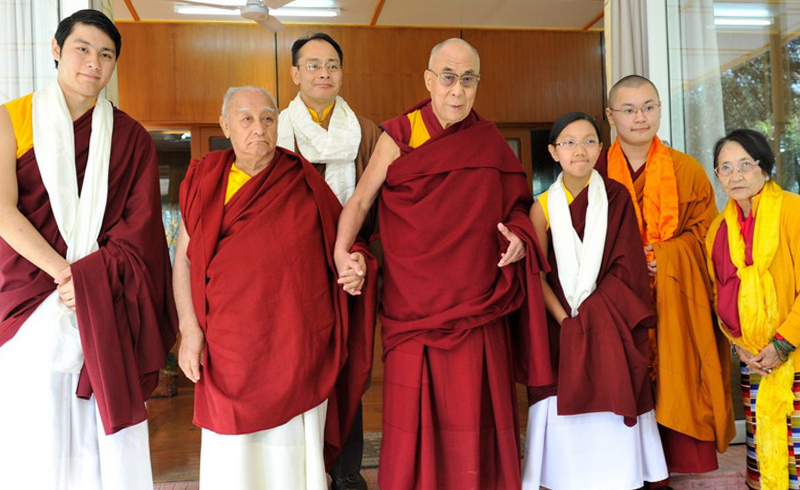
His Holiness the Dalai Lama with His Holiness Jigdal Dagchen Sakya and Phuntsok Phodrang family members
His Holiness Jigdal Dagchen Sakya was born in Tibet in 1929 and served as the head lama of the Phuntsok Phodrang until his passing in 2016. His Holiness received all of the lineage teachings from the last Sakya throne holder, his father Dorje Chang Trichen Ngawang Thutop Wangchuk. His Holiness lived in the United States with his family since 1960 and, with the late Dezhung Rinpoche, co-founded one of the first Tibetan Buddhist centers in the West. Later, His Holiness established Sakya Monastery in Seattle, Washington, as his seat in the United States. His grandsons Avikrita Vajra Rinpoche, Asanga Vajra Rinpoche, and Abhaya Vajra Rinpoche are following the footsteps of their Sakya forefathers.
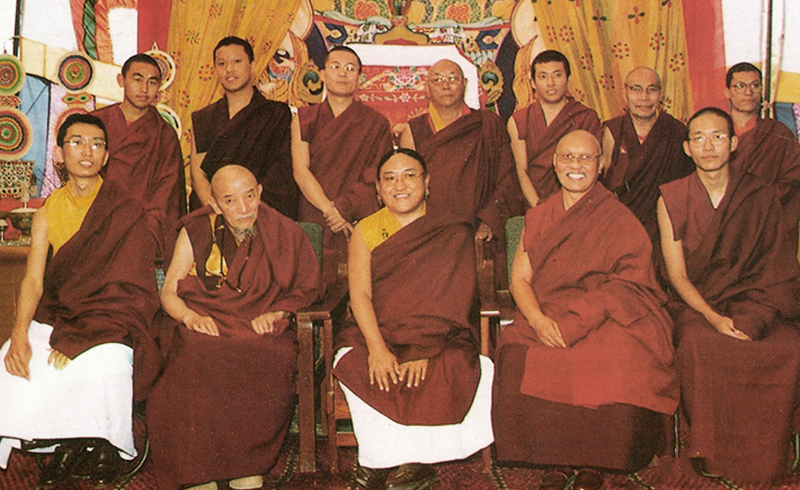
His Holiness Kyabgon Gongma Trichen with senior lineage holders
Contemporary heads of the Sakya sub-traditions include Luding Khenchen Rinpoche, Luding Khen Rinpoche, and Thartse Khen Rinpoche of the Ngor tradition; Chogye Trichen Rinpoche and Chogye Shabdrung Rinpoche of the Tsar tradition; and Gongkar Dorje Denpa Rinpoche of the Dzongpa tradition. Among the great abbots of the Sakya order, the late Khenpo Kunga Wangchuk and Khenpo Appey Rinpoche were renowned for their efforts in re-establishing the Buddha Dharma in exile.
For More Information
>The Sakya Lineage (video teaching by His Holiness Kyabgon Gongma Trichen)
>The Sakya Tradition of Tibetan Buddhism (website of His Holiness Kyabgon Gongma Trichen)
>About Tsechen Kunchab Ling (Walden, NY)
>Introduction to Sakya Monastery (Seattle, USA)
>Dhongthog Rinpoche’s Sweet Harmonies for the Infinite Realms: The History of the Precious Teachings of the Glorious Sakyapas, the Regents of the Sage in the North (translated by Sam van Schaik in The Sakya School of Tibetan Buddhism: A History).
Sakya Teachings
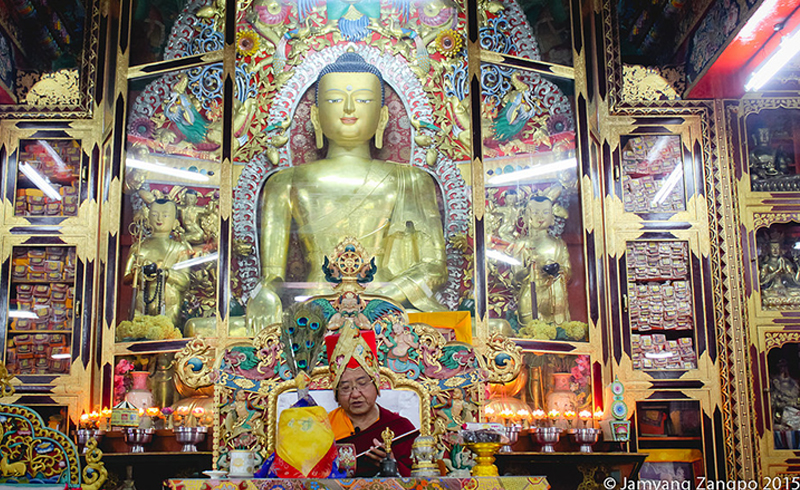
His Holiness Kyabgon Gongma Trichen at Sakya Centre, India, bestowing teachings
The Sakya lineage holders received and mastered profound tantric practices. The specialties of the Sakya lineage include:
- From Guru Padmasambhava, the unbroken oral transmission of Vajrakilaya, known for its power to subdue obstacles. The Khon family has performed the Vajrakilaya ritual without break for centuries. Today, this ritual is performed at many Sakya monasteries, including Sakya Centre in India.
- From Drogmi Lotsawa, Mahasiddha Virupa’s Lamdre tradition (the Path and Its Result) based on the Hevajra Tantra. The Lamdre contains the complete path to spiritual liberation and is the heart of the Sakya tradition. The philosophical view expressed in the Lamdre is the non-differentiation of samsara and nirvana.
- From Mal Lotsawa, the Chakrasamvara cycle and esoteric Vajrayogini practice of Mahasiddha Naropa.
- From Bari Lotsawa, the hundred methods of accomplishment and innumerable tantras.
- From Lotsawa Rinchen Zangpo, tantras of the yoga classification and other cycles, including the practice of Sarvavid Vairochana known for its efficacy in purification.
- The Thirteen Golden Dharmas, which contain practices for both supreme and ordinary accomplishment.
Additionally, the Sakya tradition is grounded in the middle way (madhyamika) philosophy of Arya Nagarjuna, which is derived from the sutra tradition. All the Sakya colleges focus their studies on this philosophy. Further, Sakya masters have authored commentaries that form a curriculum of Dharma study to this day. Although an exhaustive list is not possible here, some of these great works include:
- Sachen Kunga Nyingpo’s Parting from the Four Attachments.
- Sakya Pandita’s Treasury of Logic on Valid Cognition, A Clear Differentiation of the Three Codes, Clarifying the Sage’s Intent, Elegant Sayings, and The Entrance Gate for the Wise.
- Chogyal Phagpa’s Advice of the Precious Jewel Garland.
- Ngorchen Konchog Lhundrub’s Three Visions.
- Gorampa Sonam Senge’s Distinguishing the Views.
